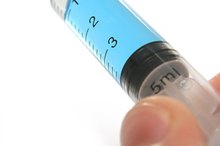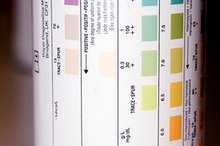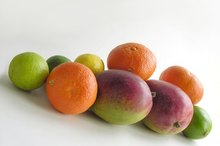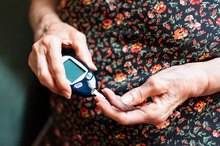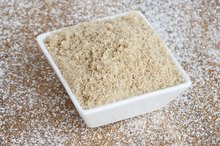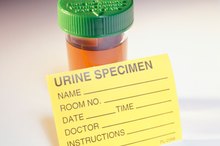How to Test Foods for Sugars
The precise amount of sugar in food can be determined from the nutrition fact label found on packaged food or from USDA food charts. However, you can also determine the amount of sugar in foods by performing an easy science experiment. Doctors use glucose test strips to screen patients for diabetes 1. The test strip changes color to indicate the presence and amount of glucose in a liquid, typically urine. By mixing food and water, you can use the resulting liquid and a test strip to test a food for sugar, according to Science Buddies 1.**
Choose a food item that has a light-colored juice. Dark-colored juice will make it difficult to see the color change in the test strip. For example, apricots would be a better choice than blueberries.
How to Test for Lipids in Food
Learn More
Place a glucose test strip on a piece of white paper towel. The paper towel provides a neutral background to view the color change as well as being able to blot excess liquid.
Mash 1 tsp. of the test food in the bowl along with 1 tsp. of water. Mash the food completely using a fork. If the food absorbs all of the water, add an additional 1 tsp. of water.
The Effect of Benedict Solution on Glucose
Learn More
Pour the test liquid through a coffee filter to filter out any food particles. If you are testing a fruit juice without pulp, omit this step.
Draw up some of the test liquid using the medicine dropper. Add 2 drops of the liquid to the test spot on the glucose test strip. The test spot will be a raised white square. Do not add too much liquid or the test spot may dissolve.
Wait 30 seconds before reading the test strip. Compare the resulting color to the color chart on the side of the test strip bottle. The exact color change will depend on the type and brand of urine test strip. One common brand, for example, will change from blue for zero glucose through to olive green for 500 mg/dl and red for more than 2,000 mg/dl.
Tips
You can purchase urine glucose test strips from your local pharmacy. Make sure you request the urine test strips and not the blood test strips. If the test strip you purchase checks for more than glucose, note the location of the glucose test spot before beginning the experiment. The side of the test strip bottle will give you this information.
Warnings
The test strip is specific for the presence of the sugar glucose. The test strip may not indicate the presence of other sugars such as maltose.
Related Articles
References
- Science Buddies: How Sweet It Is! Measuring Glucose in Your Food
- American Diabetes Association. 2. Classification and Diagnosis of Diabetes: Standards of Medical Care in Diabetes—2020. Diabetes Care. 2020;43(Suppl 1):S14-S31. doi:10.2337/dc20-S002
- American Diabetes Association. Hypoglycemia (low blood sugar).
- American Diabetes Association. Diabetes overview: Diagnosis.
- National Institute of Diabetes and Digestive and Kidney Diseases. Diabetes and prediabetes tests. Updated April 2014.
- American Diabetes Association. 6. Glycemic Targets: Standards of Medical Care in Diabetes—2020. Diabetes Care. 2020;43(Suppl 1):S66-S76. doi:10.2337/dc20-S006
- American Diabetes Association. Diabetes overview: Diagnosis.
- National Institute of Diabetes and Digestive and Kidney Diseases. Cushing's syndrome. Updated May 2018.
- Hyperglycemia and Adverse Pregnancy Outcome (HAPO) Study Cooperative Research Group. Hyperglycemia and Adverse Pregnancy Outcome (HAPO) study: preeclampsia. Am J Obstet Gynecol. 2010;202(3):255.e1-7. doi:10.1016/j.ajog.2010.01.024
- Kikuta K, Masamune A, Shimosegawa T. Impaired glucose tolerance in acute pancreatitis. World J Gastroenterol. 2015;21(24):7367-74. doi:10.3748/wjg.v21.i24.7367
- Wernly B, Lichtenauer M, Hoppe UC, Jung C. Hyperglycemia in septic patients: an essential stress survival response in all, a robust marker for risk stratification in some, to be messed with in none. J Thorac Dis. 2016;8(7):E621-4. doi:10.21037/jtd.2016.05.24
- Ishihara M. Acute hyperglycemia in patients with acute myocardial infarction. Circ J. 2012;76(3):563-71. doi:10.1253/circj.cj-11-1376
- Galati SJ, Rayfield EJ. Approach to the patient with postprandial hypoglycemia. Endocr Pract. 2014;20(4):331-40. doi:10.4158/EP13132.RA
- Desimone ME, Weinstock RS. Non-diabetic hypoglycemia. In: Feingold KR, Anawalt B, Boyce A, et al., editors. Endotext [Internet]. South Dartmouth (MA): MDText.com, Inc.; 2000-. Updated September 23, 2017.
Resources
Tips
- You can purchase urine glucose test strips from your local pharmacy. Make sure you request the urine test strips and not the blood test strips. If the test strip you purchase checks for more than glucose, note the location of the glucose test spot before beginning the experiment. The side of the test strip bottle will give you this information.
Warnings
- The test strip is specific for the presence of the sugar glucose. The test strip may not indicate the presence of other sugars such as maltose.
Writer Bio
Stacey Anderson began writing in 1989. She published articles in “Teratology,” “Canadian Journal of Public Health” and the "Canadian Medical Association Journal” during her time in medical genetics studying birth defects. She has an interest in psychology, senior health and maternal and child health. Anderson holds a Bachelor of Science in psychology with a minor in biology from the University of Calgary.

